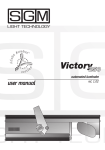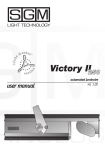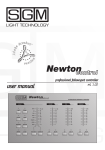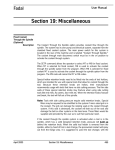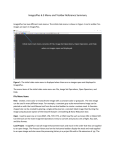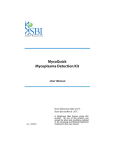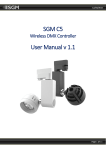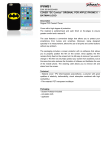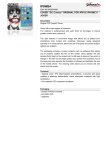Download Newton
Transcript
Newton 12 1200 professional followspot rel. 1.02 user manual 45 30 Newton 1200 30 45 General warnings Carefully read the warnings contained in this manual, since they supply important instructions concerning safety of installation, use and maintenance. It is very important that this manual be kept with the equipment for future consultation. In case of sale or transfer of the equipment to another user, ensure that this manual always accompanies the equipment to allow the new owner to obtain information about the operation and the relevant warnings. • After unpacking check the integrity of the equipment. In case of doubt, do not use the equipment, and contact an authorized SGM Technical Service Centre. • The packaging materials (plastic bags, expanded polystyrene, nails, etc.) must be kept out of reach of children since they are potential sources of danger. • This equipment may only be operated by adults. Do not allow children to tamper with the machine or play with the product. • The electrical work necessary for the installation of the equipment must be carried out by a qualified electrician or by a competent person. • Before connecting the unit, check that the data on the registration plate is the same as that of the electrical grid. • Avoid using the equipment: - in places subject to excessive humidity - in places subject to vibrations or knocks - in places with temperatures higher than 45°C or lower than 2°C - Protect the equipment from excessively humid conditions (the optimum values are between 35 and 80%). • Do not disassemble or modify the equipment. • Prevent inflammable liquids, water or metallic objects from penetrating the equipment. • In case of spilling liquid on the equipment, immediately disconnect the power supply of the mixer. • The minimum distance between the projector and the surface to be illuminated must not be less than 1.5 m. • In case of serious functioning problems, switch off the equipment and contact the nearest SGM retailer or the manufacturer directly for inspection. • Avoid opening the equipment: there are no parts repairable by the user. • Never try to repair the equipment alone. Repairs carried out by inexpert persons may cause damage Always insist on original spare parts. Protect the environment: do not throw the packaging in your dustbin, but return it to your retailer or take it to a collection point for special waste disposal. EN I D F E appendice page 1 or serious malfunctioning. Contact the nearest authorised Technical Service Centre. Index 1 General warnings 2 Index 3 Main Characteristics 3 Lamp 3 Optics 3 Dimmer 3 Shutter 4 Colour 4 Strobe 4 Iris 5 Technical Specifications 6 Control microcomputer functions 6 input signal 6 start address 7 lamp hour counter 7 projector hour counter 7 projector auto test 7 firmware release 8 Newton Optics 8 Newton Connections 10 Newton Maintenance 10 Access to inside 10 Lamp mounting or replacement 10 Projector cleaning / Periodic checks 10 Colour replacement 11 Access to control electronics Control Channels 12 ch 1 - iris 12 ch 2 + ch 5 - colour + colour mode 13 ch 3 - dimmer 13 ch 4 - shutter/strobo page 2 12 Made in Italy by SGM Electronic Printed in February, 1998 • Rel. 1.02 Main Characteristics The Newton intelligent followspot springs from the sophisticated, reliable and consolidated Galileo projector technology. This new spotlight was conceived for professional use (theatre, TV or live concerts), but because of its simple operation is suitable for any application. Newton revolutionizes the conventional spotlight concept, as all the levers and knobs are replaced by the electronic control unit, Newton Control (or any other DMX controller), for much more rapid, more simple and more precise control, also at a considerable distance from the projector. The attractive design of the Newton projector also makes it aesthetically interesting, while the constructive characteristics make the projector robust, safe, reliable and easy to transport. The vast and pluridecennial experience of SGM in the sector of light control systems has allowed developing a product with high reliability and precision, of which the mechanics, optics and electronics are entirely designed by our own research laboratories. This allows absolute mastery of the know-how and optimisation of the quality/price relation. The Newton electronic system, as the mechanical and optical system, is modular, so that each function has its own electronic card independent of the others. This notably facilitates maintenance, translating into considerably lower operating costs. Newton is equipped with an auxiliary power supply circuit which protects the projector and the surrounding equipment from radio interference. The projector is constructed in conformity with EEC regulations. Lamp Newton uses a 1200 Watt HMI metallic halide-vapour lamp (alternate current discharge) in which the arc is maintained in an atmosphere with rare earth halide vapours. Extremely high luminous efficiency (up to 100 lm/W), daylight colour temperature of about 6000°K and a high chromatic yield index (Ra>90), are some of the lamp characteristics which guarantee very high stability of the colour temperature during its lifetime (not less than 750 hours), unlike conventional lamps which darken and burn out prematurely. They have a dual connector with a particularly short distance between the electrodes and hence higher luminance with consequent improvement of projector efficiency. Optics The special Newton optical unit guarantees luminosity superior to that of any other projector in the same category at parity of light source. Thanks to the double condenser lens the quantity of light emitted is fully exploited, concentrated and boosted. The luminous beam is perfectly uniform and the light homogeneously distributed without concentrations and haloes on the illuminated area. The lenses are top-quality with a high transmission coefficient and with special antireflection treatment. Dimmer Newton is equipped with a new linear mechanical dimmer which, with movement towards the centre of two palettes, allows extremely accurate, continuous and uniform control of light output quantity from real zero to 100%. Shutter page 3 The Newton shutter can be inserted instantaneously to block luminous beam output. EN I D F E appendice Colour Newton offers a range of 7 colours obtained through 46 mm ∆ dichroic filters, easily interchangeable, so that also special needs can be satisfied. The dichroic filters are top-quality and carefully selected. SGM dedicates particular care in the selection of these filters, so that different projectors used simultaneously produce perfectly uniform colours. The colour filters may be selected as follows: • fixed positions, full colour • intermediate positions in any position, or prefixed intermediate positions • variable-speed rotation of the colour wheel to obtain a spectacular rainbow effect • passage from one colour to another without blackout • automatic colour change with adjustable interval selectable between fixed or intermediate positions The passage between the different colours is imperceptible to the human eye as it is extremely fast, the absolute fastest, and occurs in 0.06 seconds. Strobe The Newton strobe, extremely fast and silent, allows adjusting the flashing frequency between 0.5 and 12 flashes per second. The high number of flashes creates an effect very similar to that of projectors designed for this single purpose. The shutter system, operated by means of two palettes rather than one, produces a true blackout emphasising the stroboscopic effect. The strobe may be selected simultaneously with the dimmer, therefore the strobe effect can be obtained together with light intensity adjustment. Iris page 4 The innovative and exclusive iris diaphragm is fitted with a device allowing aperture/closure at an unequalled operating speed: 0.1 sec. Diameter variation is perfectly linear under full control of the operator. Other than for simply narrowing the luminous beam according to need, the iris diaphragm is also used to create special visual effects not obtainable with other projectors. The quietness of the system (<30 dB) allows use also in those places (theatres and TV rooms) where this feature is an indispensable condition. The diaphragm is constructed in special nickel-chrome steel with high thermal resistance and certain non-deformability, which guarantee perfect efficiency over time, even in very severe operating conditions. POWER SUPPLY 220/240 V - 50/60 Hz LAMP HMI 1200, powered by incorporated power supply. SFC base 15.5-6. Flux Lumen 110,000. Life + 750 hours. Hour counter through “Control” microcomputer, resettable after each lamp change. ABSORBED POWER 1500 W, internally rephased ELECTRONICS Entirely developed by the SGM Research & Development Laboratory. Power supply card (CS 0180), mother board (CS 0181) on which the various function control cards are mounted (CS 0183-CS0184), and signal decoder (CS 0192). MICROCOMPUTER (CSO 186) with LED display to set projector functions or obtain useful information (“Control” unit). MOTORS 4 microprocessor-controlled stepper motors INPUT DMX512, RS-232 digital serial signal CONTROL SYSTEM Newton is controlled by 5 DMX channels, corresponding to the following functions: ch 1 = iris / ch 2 = colour / ch 3 = dimmer ch 4 = strobe / ch 5 = colour mode SETTINGS Addressing from “Control” microcomputer with LED display. OPTICAL UNIT In die-cast aluminium with double condenser and mirrored parabola with very high luminous yield. STANDARD LENS 1:5.5/180 mm with screw focus adjustment LENSES In glass with high transmission coefficient with special multilayer antireflection treatment COOLING Forced through 3 axial fans. In conformity with European safety regulations. SAFETY REGULATIONS Manufactured in conformity with current CE regulations (safety and radio interference). SAFETY DEVICES IP 22 degree of protection. Power cable in conformity with international regulations (CEI 12-13). Automatic power cut-off in case of overheating or cooling system operation failure. BODY In die-cast extruded aluminium. Epoxy-powder enamelling. SUPPORT BRACKETS In die-cast extruded aluminium, epoxy-powder enamelled, and sheet steel. 6 installation positions with 25 mm-step. Adjustable inclination over 110°. HANDLES Four (2 per side) + grip on rear panel, considerably facilitate work during installation and use, and make the projector easier to handle. EN I D F E appendice page 5 Technical Specifications Control microcomputer functions On the rear panel Newton is equipped with a microcomputer (Control unit). Through Control the operator can access the Newton settings, as well as obtain some important information, such as the hours of life of the projector (to know when to carry out the periodic inspection) or the hours of life of the lamp (to plan lamp replacement). control scroll power on/off main & fuse control signal dmx & rs-232 in dmx & rs-232 out pinout 1=comm 2=-dmx (2=rs data) 3=+dmx PUSH enter up down scroll warning for input socket only: enter SIGN=DMX up down 4=comm 5=+12V DC input signal This is the base setting of the Control unit display, which resets automatically when exiting from any of the controls. To change the type of input signal, press the ENTER key and scroll with the UP and DOWN cursor keys until reaching the desired option out of the 2 available: DMX512 or RS-232. By pressing the ENTER key the option displayed at that moment is stored. When the connection to the DMX chain is incorrect or there is no controller, the flashing message “NO SIGNAL” will appear on the display. ADDR=xxx start address page 6 For each projector operating in DMX or RS-232 mode, it must always be specified from which of the 512 channels available the block (of the 5 Newton channels) relative to a specific projector starts. To change the start address, scroll with the UP and DOWN cursor keys until reaching the desired option and press the ENTER key. Then, again with the UP and DOWN cursor keys set the desired address and again press ENTER. The start address modification may also be made with the projector on. Warning: When Newton is driven by the dedicated Newton Control unit (Code SGM: 005-1149), the start address must be set on 001. LMP_h =xxx lamp hour counter The lamp used by Newton (HMI 1200W/GS) has a life of about 750 hours. Hence the hour counter is used to allow the operator to determine when the lamp must be replaced. To reset (set to zero) the hour counter, scroll with the UP and DOWN cursor keys until reaching the desired option and press the ENTER key. The text on the display starts flashing and when the DOWN key is pressed again, the reset is completed. Then press ENTER to end the operation. SCN_h =xxx projector hour counter The Newton spotlights, like all professional projectors, require periodic cleaning and inspection cycles. SGM recommends to carry out the cleaning cycles every 150 hours of operation and an overall check (to be carried out by specialised personnel) about every 700 hours. To view the hour counter, scroll with the UP and DOWN cursor keys until reaching the desired option and press the ENTER key. This hour counter cannot be reset, but increases its value each time Newton is switched on. This also allows evaluating the total operating life of the projector. TEST projector auto test The Newton spotlights have a resident autotest program, which may be activated at any time to check proper operation of all its functions. To activate the autotest, scroll with the UP and DOWN cursor keys until reaching the desired option and press the ENTER key. To exit from autotest press ENTER again. NEW=V.1.0 firmware release page 7 All the Newton functions are controlled by a resident program (firmware). To view which version of firmware is installed on the projector, scroll with the UP and DOWN cursor keys until reaching the desired option: the display will show the information required. EN I D F E appendice Newton Optics The Newton spotlight is series supplied with a 180 mm focus lens (1:5.5) which can be used very efficiently up to a distance of 30 m. Should greater distances be required, a 330 mm lens (1:3) is also available for projection up to 70 m (code 220-2600). The following tables show the beam apertures with the two lenses and with the iris open and closed. Standard lens/Obiettivo standard (1:5,5/180) 4 BEAM OPENING - APERTURA FASCIO 3 2 1 0 1 2 3 4 distance mt 0 10 20 30 beam diam. mt 0 2,65 5,4 8,2 beam diam. mt 0 0,75 1,6 2,4 Standard lens/Obiettivo standard (1:3/330) 4 BEAM OPENING - APERTURA FASCIO 3 2 1 0 1 2 3 4 distance mt 0 10 20 30 50 60 beam diam. mt 0 1,43 2,9 4,3 5,7 7,1 8,5 9,9 beam diam. mt 0 0,18 0,32 0,4 0,56 0,68 0,8 0,92 40 70 Newton Connections page 8 The projector is fitted with a DMX512 and RS-232/423 input/output. For connection in a DMX network always use balanced microphonic cables type RF 60/12 2x0.25mm2 or similar and select a good quality to prevent malfunctioning of the projector. To reduce interference it may be necessary to insert a network terminator on the last projector in the DMX chain, realized with a 120W 1/4W resistor placed between pins 2 and 3 of the DMX connector. Warning: The screening part of the cable (braid) must NEVER be connected to the system earth, since this would lead to malfunctioning of the projector and the control units. The Newtons allow cascade connection and they can thus be controlled in classic DMX (or RS-232) chains. Therefore, the operator is not required to control the functions, transferred to the controller or the light desk, and can concentrate on the movement quality. When using a controller or light desk, the projectors must be suitably addressed (see diagrams on following pages), while when using the dedicated Newton Control, all the projectors must be addressed to channel 001. In the first case the Newtons are independent, while in the second case they are all under the same controls. The Newtons supply power directly to the Newton Control unit, using the pins 4 and 5 of the DMX IN socket (see following diagrams). socket pin out input 5 4 3 1 2 pin 1 comm pin 2 - DMX + RS-232 pin 3 + DMX + RS-232 pin 4 comm pin 5 +12V DC pin 1 comm pin 2 - DMX + RS-232 pin 3 + DMX + RS-232 pin 4 n.c. pin 5 n.c. NEWTON #1 MAIN SUPPLY PROCESSOR DMX_SIGNAL ENTER RS-232/423 connection DIGITAL SIGNAL 3 5 4 GND 7 4 5 2 1 3 COMMON MAIN SUPPLY PUSH PROCESSOR DMX_SIGNAL RS232 1= COMM 2= RS232 PROJECTOR 5 PIN CONNECTOR TD 2 1 2 NEWTON #2 INPUT SIGNAL DMX512 1= COMM 2= - DMX 3= + DMX RS-232 COMPUTER OUT 25 PIN CONNECTOR output NEWTON #n. INPUT SIGNAL DMX512 1= COMM 2= - DMX 3= + DMX MAIN SUPPLY PUSH PROCESSOR DMX_SIGNAL RS232 1= COMM 2= RS232 ENTER OUTPUT SUPPLY 4= OV 5= +12V MAX:50mA ENTER OUTPUT SUPPLY 4= OV 5= +12V MAX:50mA INPUT SIGNAL DMX512 1= COMM 2= - DMX 3= + DMX PUSH RS232 1= COMM 2= RS232 OUTPUT SUPPLY 4= OV 5= +12V MAX:50mA Main Power page 9 DMX512 or RS-232 digital signal EN I D F E appendice










